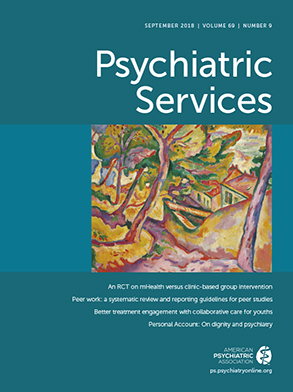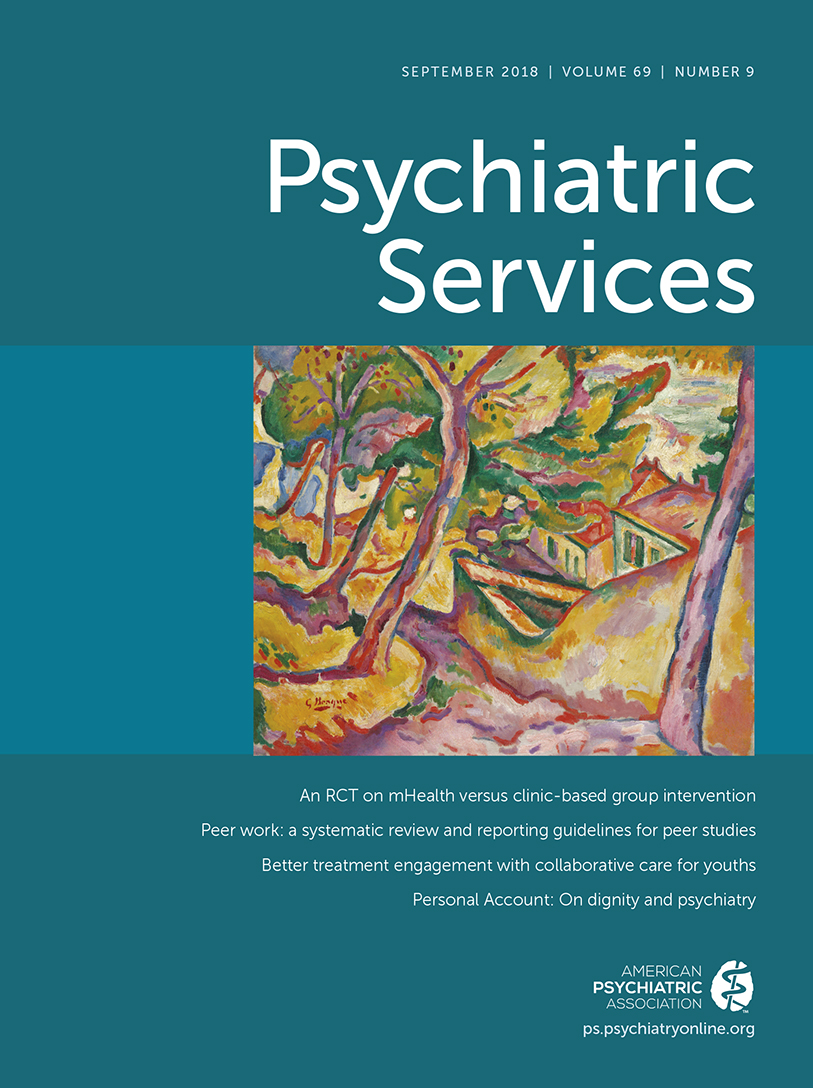Irregular hospital discharges, including against medical advice (AMA) and other unplanned discharges such as self-initiated discharge, are associated with higher rates of emergency department (ED) visits, readmissions, and mortality (
1). These adverse outcomes may reflect the fact that when patients leave the hospital precipitously, they may do so before potentially life-threatening problems are fully treated (
2), and irregular discharges may complicate treatment planning and coordination with outpatient providers. For example, a large study in the U.S. Department of Veterans Affairs (VA) health system documented elevated risks for both 30-day readmissions and 30-day mortality following AMA discharges (
3). Of particular concern is a possible association between irregular hospital discharge and suicide risk after psychiatric or medical hospitalization (
4–
8). Because acute clinical stabilization and patient engagement in discharge planning play an important role in postdischarge suicide prevention efforts, it is conceivable that an irregular hospital discharge may interfere with suicide prevention efforts, increasing a patient’s risk of suicide after discharge.
Several single-site studies have demonstrated that AMA and self-initiated discharges from psychiatric wards are associated with an elevated risk of death by suicide (
4–
6,
9). In the largest study (11,040 patients admitted to the Taipei City Psychiatric Center (Thailand) between 1998 and 2005), Kuo et al. (
4) found that the hazard of death by suicide in the two to nine years following discharge was approximately 50% higher among those with an AMA discharge than among those with a regular discharge. The relationship persisted after the analyses controlled for patient characteristics, including history of a suicide attempt. In a case-control study of 238 psychiatrically hospitalized patients in England, Hunt et al. found that patients who self-discharged were twice as likely to die by suicide in the first three months after discharge compared with a matched control group (
5). Similarly, in a case-control study of 234 psychiatrically hospitalized patients in Wessex, England, King et al. found that patients who underwent an unplanned discharge were almost three times as likely to die by suicide in the year following hospitalization (
6). Conversely, however, a study of 120 consecutive patients who died by suicide following discharge from a psychiatric unit in England did not find any association between AMA discharge and suicide risk (
10). The apparent association between irregular discharge and suicide risk may also be explained by a number of confounders. For example, being male and a younger age are known predictors of AMA discharge and are risk factors for suicide (
1).
Except for the Chestnut Lodge Follow-Up Study, a single-site cohort of severely ill psychiatric inpatients who were followed after discharge in the 1970s and 1980s, we know of no study regarding the association between discharge type and suicide risk in the United States (
9). Furthermore, to the best of our knowledge, no studies have reported on suicide rates after general medical hospitalization. There has been only one study reporting on a possible association between irregular discharge and suicide risk after general medical hospitalization. In an analysis of root cause analysis (RCA) reports of suicide deaths among patients leaving general medical wards, Riblet et al. found that 16% of the reports noted that the patient’s death by suicide followed an AMA or other unplanned discharge (
7). The RCA process, however, is not designed to measure the population at risk (denominator), and some suicides after an irregular discharge (numerator) may not have been evaluated with RCA.
To inform ongoing VA suicide prevention activities, this study assessed whether irregular discharge following psychiatric and general medical hospitalization in the VA health system is a suicide risk factor. Study objectives were as follows: to determine whether irregular hospital discharge was associated with an increased 1-year risk of death by suicide and to determine how irregular hospital discharge affected a 1-year risk of death by suicide after discharge from psychiatric wards versus general medical wards. We hypothesized that the risk of suicide would be higher among patients who are discharged irregularly versus regularly from a psychiatric or general medical ward.
Methods
Using the VA national administrative data, we identified all VA inpatient discharges from 2001 through 2014 and obtained indicators regarding patient demographic characteristics and discharge type (categorized as regular or irregular in the discharge order). Vital status and cause of death information was drawn from the Centers for Disease Control and Prevention National Death Index (NDI) data included in the VA/U.S. Department of Defense Suicide Data Repository (SDR), with deaths in the 50 U.S. states and the District of Columbia. Suicides were indicated by
ICD-10-CM cause of death codes X60–X84 and Y87.0 (
11).
The analysis included all patients discharged from a VA acute inpatient ward between 2001 and 2014. Indicators included patient age, gender, discharge type, and the VA facility from which they were discharged. For decedents, we determined the number of days from the discharge to death. For patients with multiple discharges in a given year, we used the first inpatient discharge as the index discharge.
We assessed the rate of suicide per 100,000 person-years by ward type (psychiatric and general medical wards) and by discharge type (regular and irregular discharge). We performed Cox survival analysis, comparing risk of death by suicide with ward type and discharge type. Risk time was from the initial discharge in the year until death or the end of the observation period, whichever came first. We defined the observation period as 12 months after the individual’s first discharge in a given year. We calculated both raw HRs and HRs adjusted for age, gender, and the VA facility from which patients were discharged. All analyses were completed in SAS, version 9.4. This study was conducted as part of ongoing suicide analytics in the VA Office of Mental Health and Suicide Prevention, and this ongoing work has approval from the VA Ann Arbor Institutional Review Board.
Results
There were 5,051,051 discharges from any type of unit (general medical or psychiatric) between 2001 and 2014, of which 103,995 (2.1%) were categorized as irregular. Of the 798,696 total discharges from psychiatric wards, 33,472 were irregular discharges (4.2%) Of the 4,252,355 total discharges from general medical wards, 70,523 were irregular discharges (1.7%). There were 666,674 deaths that occurred within 12 months of the index discharge date, of which 5,337 were suicide deaths. Of the suicide deaths, 4.9% (N=261) followed a documented irregular discharge.
Table 1 compares suicide risk in the year following hospital discharge by unit type. As expected, regardless of discharge type, suicide rates were higher among patients who were discharged from a psychiatric unit compared with a general medical unit. However, the magnitude of the difference in suicide rates between psychiatric and general medical units was less pronounced among irregular discharges than among regular discharges (HR=1.76 and 4.33, respectively). When considering the risk for suicide between discharge types from any type of unit, irregular discharge was associated with a twofold increase in 1-year suicide risk compared with regular discharge (adjusted HR=2.02, CI=1.78–2.29). Irregular discharge did not convey an increased risk of suicide compared with regular discharge from psychiatric units. However, patients leaving general medical units following irregular discharge had three times the 1-year risk of suicide compared with patients leaving general medical units following a regular discharge (adjusted HR=3.01, CI=2.54–3.57).
Discussion and Conclusions
Among patients in the VA health system, irregular hospital discharge was associated with greater risk of suicide in the year after discharge. Findings from this national health system analysis are similar to those of single-site studies that have documented increased risk of suicide following AMA discharges (
4–
6,
9). For example, akin to our results, Kuo et al. reported that suicide risk was approximately 50% higher among psychiatric inpatients who were discharged AMA than among patients who were discharged regularly (adjusted HR=1.43, CI=1.05–1.95) (
4). However, our study findings diverge from those of prior work in that we found that suicide risks did not differ significantly between patients who were regularly versus irregularly discharged from a psychiatric ward. Instead, the increased risk of suicide associated with irregular discharge seems concentrated among patients discharged from general medical wards. This observation may be a function of the already elevated postdischarge suicide risk among patients leaving VA psychiatric wards (
12). The prevalence of irregular discharges in our study population was similar to figures reported in the literature (i.e., 1%−2% among general medical discharges and 3%−51% among psychiatric discharges) (
1,
13).
Our finding that that the risk of death by suicide was increased threefold after irregular discharge from general medical wards is unique because, to the best of our knowledge, no study has evaluated suicide risk following a general medical hospitalization. Study findings indicate that, in the VA health system, one-year suicide risks after irregular discharges from a general medical ward are similar to those of patients with regular discharges from psychiatric wards. Consequently, patients with irregular discharges from inpatient general medical units may represent an important targeted group for suicide prevention efforts.
There were several limitations to our study. First, although many patient demographic, diagnostic, and service use factors contribute to risk of death by suicide (
12), study analyses accounted only for patient age, gender, and VA facility. In this initial study, we avoided overcontrolling for factors that might be in the causal pathway linking irregular discharge and death by suicide. Future analyses should explore the patient and health system factors that are associated both with irregular discharge and with death by suicide. For example, prior work examining VA general medical ward discharges used the Elixhauser Comorbidity Index and found that both alcohol use disorders and psychotic disorders were over twice as prevalent in the AMA discharge patient population as in the regular discharge population (
3). Second, our work only examines these trends in the rate of death by suicide after irregular hospital discharge for individuals treated in the VA health system. Prior work has demonstrated higher risk of death by suicide in this population compared with the general U.S. population (
14). It is possible that these trends would differ in health systems treating patients at lower risk for suicide. This highlights potential limits on generalizability beyond the VA health system.
Study findings offer important information regarding patient subpopulations that could be targeted for suicide prevention activities. It appears that patients discharged irregularly are such a patient group. Following initial RCA findings that a high percentage of postmental health–discharge suicide deaths followed an irregular discharge (
8), the VA initiated a requirement in July 2017 that patients be offered follow-up in person within 24 hours of an AMA discharge from an inpatient psychiatric ward (
15). Although this requirement is designed to ensure that patients leaving psychiatric wards have an adequate discharge plan and the resources that they need for a successful discharge, future work should focus on the effectiveness of this and other strategies at preventing death by suicide after discharge. This work would also support the development of similar interventions for patients who have irregular discharges from general medical wards.

